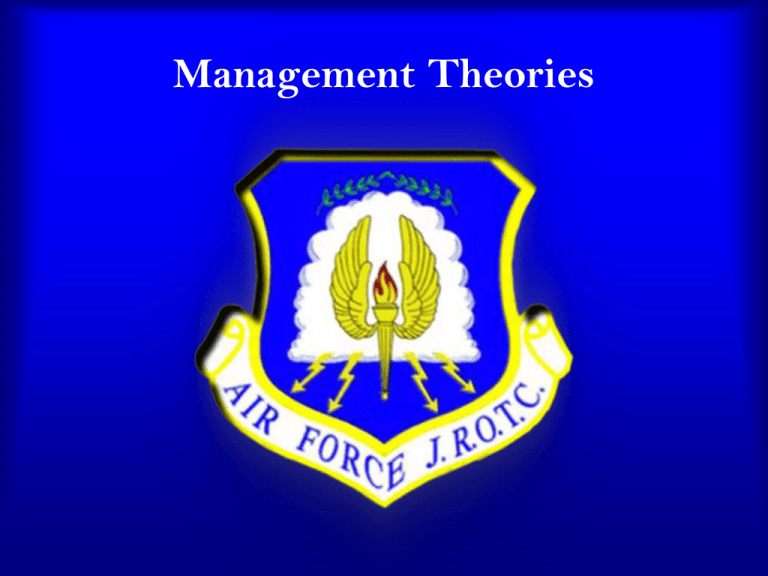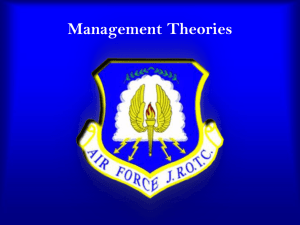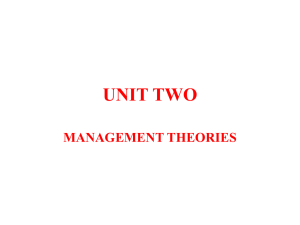
Management Theories
Overview
Know the history of
management before
the modern era
Know the classical
contributions to
modern management
Late 1800’s Weaving Shed
Chapter 2 Lesson 1
Courtesy of Photos.com
Quick Write
Do you know someone who isn’t called a
manager but who works like one? Explain.
Chapter 2 Lesson 1
Courtesy of Goodshoot images
History of Management
Before the Modern Era
Frederick Taylor
Michelangelo
Chapter 2 Lesson 1
Courtesy of Clipart.com
Adapted from Fundamentals of Management, 5th Ed.
By Robbins/DeCenzo, p. .17
Pearson Prentice Hall, 2005
Adam Smith
Division of labor—the breakdown of jobs into
narrow, repetitive tasks
Workers become very skilled at the one task
they are doing
Saves time because workers are not moving
from one task to the next
Helped pave the way for mechanization of
work
Led to automation and computerization
Chapter 2 Lesson 1
The Industrial Revolution
The advent of machine
power, mass production,
and efficient
transportation, which
began in Britain in the
late eighteenth century
Watt Steam Engine
Chapter 2 Lesson 1
Courtesy of Photos.com
The Industrial Revolution
Machine Power
Mass Production
Relatively Cheap Transportation
Lack of Governmental Regulation
Large Organizations
Chapter 2 Lesson 1
The Industrial Revolution
John D. Rockefeller
– Standard Oil
Andrew Carnegie –
Carnegie Steel
Chapter 2 Lesson 1
Taken from Wikipedia.com
The Industrial Revolution
Large Labor Forces
New-Style Corporations
Formal Structures
Formal Management Practices
Chapter 2 Lesson 1
What Do You Think?
What are some examples of large,
modern corporations?
How are these organizations organized?
What kind of departments do these
organizations have?
How does this relate to Adam Smith’s
theory of the division of labor?
Chapter 2 Lesson 1
Classical Contributions to
Modern Management
Chapter 2 Lesson 1
Courtesy of Photos.com
Frederick Taylor
Published The Principles of Scientific Management
in 1911
Used the scientific method to determine the “one
best way” to do a job, and to train workers to do it
that way
Demonstrated to workers and managers that both
would benefit by improved production efficiency
Chapter 2 Lesson 1
Frank & Lillian Gilbreth
Students of Frederick Taylor
Studied work arrangements to eliminate
wasteful hand and body motions
Examined the design and use of tools and
equipment to determine how these could
contribute to work performance
Chapter 2 Lesson 1
Henry Gantt
Devised a bonus system that gave workers
extra money if they finished their work in
less time than the standard
Studied the efficiency of managers and
workers
Created the Gantt chart ~ a graphic device
managers use to plan and control work
Chapter 2 Lesson 1
A Gantt Chart
1
2
3
4
Copy/edit manuscript
Design sample pages
Draw Artwork
Print Galley Proofs
Print Page Proofs
Design Cover
Adapted from Fundamentals of Management, 5th Ed.
By Robbins/DeCenzo, p. 474
Pearson Prentice Hall, 2005
Chapter 2 Lesson 1
Why Scientific Management?
Productivity was low in the world of work
in the early twentieth century
Better productivity by manual laborers
could make a real difference
Chapter 2 Lesson 1
Henri Fayol
Designated management as a universal set of
activities
Looked at the activities of all kinds of managers
Wrote from personal experience as a manager
Stated 14 principles of management—fundamental
or universal truths of management practice
Chapter 2 Lesson 1
Fayol’s 14 Principles
Divison of work
Authority of managers to give orders
Discipline of employees
Unity of command
Unity of direction
Subordination of individual interests to the
general interest
Chapter 2 Lesson 1
Fayol’s 14 Principles
Remuneration of workers
Centralization of decision-making
Scalar Chain ~ authority from top to
bottom
Order of people and materials
Equity of treatment
Stability of tenure of personnel
Initiative of employees encouraged
Esprit de Corps
Chapter 2 Lesson 1
Max Weber
Described bureaucracy ~ an ideal type of
organization with a division of labor, clearly
defined hierarchy, detailed rules and
regulations, and impersonal relationships
Model of the way work could be done in
large groups
Model used in many large organizations
today
Chapter 2 Lesson 1
Today’s Applications
Matching people to jobs and training
workers to be more effective are ideas
Taylor introduced
Industrial engineering, which is all about
the details of processes, is a field with its
roots in scientific management
Chapter 2 Lesson 1
Today’s Applications
Football coach who shows his team the tapes of
last week’s game to get them to do better next
week is picking up on an idea the Gilbreths
introduced
Chapter 2 Lesson 1
Courtesy of BrandX Images
What Do You Think?
What are some examples of the division of
labor, scientific management, or
bureaucracy that we see at work in the Air
Force or in our Air Force JROTC unit?
Chapter 2 Lesson 1
Review
Adam Smith introduced the concept of division of
labor—the breakdown of jobs into narrow, repetitive
tasks
One of the most important developments influencing
management practice before the twentieth century was
the Industrial Revolution—the advent of machine power,
mass production, and efficient transportation, which
began in Britain in the late eighteenth century
Modern management theory began with a group of
managers and writers who tried to come up with some
basic principles for companies to follow to work more
efficiently
Chapter 2 Lesson 1
Review
The classical approach to management introduced the
ideas of the scientific management theorists and the
general administrative theorists
General administrative theorists—writers who developed
general theories of what managers do and what good
management practice is—were concerned with the
overall organization and how to make it more effective
Frederick Taylor described the theory of scientific
management—the use of the scientific method to
determine the “one best way” to do a job, and to train
workers to do it that way
Chapter 2 Lesson 1
Review
Frank and Lillian Gilbreth studied work arrangements
to eliminate wasteful hand and body motions and the
design and use of tools and equipment to determine
how these could contribute to work performance
Henry L. Gantt devised a bonus system that gave
workers extra money if they finished their work in less
time than the standard
Scientific theory got so much attention because
productivity was low in the world of work in the early
twentieth century and better productivity could make a
real economic difference
Chapter 2 Lesson 1
Review
Henri Fayol stated 14 principles of management—
fundamental or universal truths of management practice
Max Weber described what he called a bureaucracy—an
ideal type of organization with a division of labor, clearly
defined hierarchy, detailed rules and regulations, and
impersonal relationships
The football coach who shows his team the tapes of last
week’s game to get them to do better next week is
picking up on an idea introduced by the classical
approach to management
Chapter 2 Lesson 1
Summary
Management before the modern era
Classical contributions to modern
management
Chapter 2 Lesson 1
What’s Next…
Management Approaches
Chapter 2 Lesson 1
Courtesy of Clipart.com





